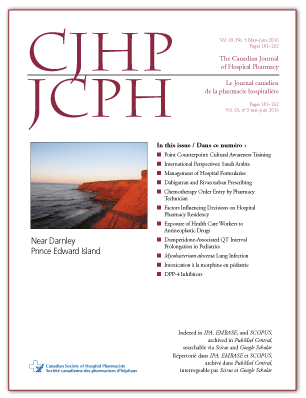Chemotherapy Order Entry by a Clinical Support Pharmacy Technician in an Outpatient Medical Day Unit
DOI:
https://doi.org/10.4212/cjhp.v69i3.1556Keywords:
pharmacy technician, clinical support, chemotherapy order entry, time- and- motion studiese, technicien en pharmacie, soutien clinique, saisie d’ordonnances de chimiothérapie, études des temps et mouvementsAbstract
ABSTRACT
Background: Pharmacy technicians are expanding their scope of practice, often in partnership with pharmacists. In oncology, such a shift in responsibilities may lead to workflow efficiencies, but may also cause concerns about patient risk and medication errors.
Objectives: The primary objective was to compare the time spent on order entry and order-entry checking before and after training of a clinical support pharmacy technician (CSPT) to perform chemotherapy order entry. The secondary objectives were to document workflow interruptions and to assess medication errors.
Methods: This before-and-after observational study investigated chemotherapy order entry for ambulatory oncology patients. Order entry was performed by pharmacists before the process change (phase 1) and by 1 CSPT after the change (phase 2); order-entry checking was performed by a pharmacist during both phases. The tasks were timed by an independent observer using a personal digital assistant. A convenience sample of 125 orders was targeted for each phase. Data were exported to Microsoft Excel software, and timing differences for each task were tested with an unpaired t test.
Results: Totals of 143 and 128 individual orders were timed for order entry during phase 1 (pharmacist) and phase 2 (CSPT), respectively. The mean total time to perform order entry was greater during phase 1 (1:37 min versus 1:20 min; p = 0.044). Totals of 144 and 122 individual orders were timed for order-entry checking (by a pharmacist) in phases 1 and 2, respectively, and there was no difference in mean total time for order-entry checking (1:21 min versus 1:20 min; p = 0.69). There were 33 interruptions not related to order entry (totalling 39:38 min) during phase 1 and 25 interruptions (totalling 30:08 min) during phase 2. Three errors were observed during order entry in phase 1 and one error during order-entry checking in phase 2; the errors were rated as having no effect on patient care.
Conclusions: Chemotherapy order entry by a trained CSPT appeared to be just as safe and efficient as order entry by a pharmacist. Changes in pharmacy technicians’ scope of practice could increase the amount of time available for pharmacists to provide direct patient care in the oncology setting.
RÉSUMÉ
Contexte : Les techniciens en pharmacie élargissent leur champ de pratique, souvent en partenariat avec les pharmaciens. En oncologie, un tel changement dans les responsabilités pourrait conduire à une optimisation de l’organisation du travail, mais il peut aussi soulever des inquiétudes au sujet des risques pour le patient et des erreurs de médicaments.
Objectifs : L’objectif principal était de comparer le temps passé à la saisie d’ordonnances et à la vérification de cette saisie avant et après avoir formé un technicien en pharmacie dédié au soutien clinique (TPDSC) à la saisie d’ordonnances de chimiothérapie. Les objectifs secondaires étaient de répertorier les interruptions de travail et d’évaluer les erreurs de médicaments.
Méthodes : La présente étude observationnelle avant-après s’est intéressée à la saisie d’ordonnances de chimiothérapie pour les patients ambulatoires en oncologie. La saisie d’ordonnances était réalisée par des pharmaciens avant le changement de procédé (phase 1), puis, après le changement (phase 2), un TPDSC en avait la responsabilité. Un pharmacien vérifiait la saisie d’ordonnances au cours des deux phases. Les tâches étaient chronométrées par un observateur indépendant à l’aide d’un assistant numérique personnel. Un échantillon de commodité de 125 ordonnances était souhaité pour chaque phase. Les données ont été consignées dans un tableur Excel de Microsoft et les écarts de temps pour chaque tâche ont été évalués à l’aide d’un test t pour échantillons indépendants.
Résultats : Au total, on a chronométré le temps de saisie pour 143 ordonnances à la phase 1 (pharmacien), puis de 128 ordonnances pour la phase 2 (TPDSC). Le temps total moyen nécessaire pour saisir une ordonnance était plus long au cours de la phase 1 (1 min 37 s contre 1 min 20 s; p = 0,044). Au total, on a chronométré la vérification (réalisée par un pharmacien) de saisie pour 144 ordonnances à la phase 1 et 122 ordonnances à la phase 2. Aucune différence notable n’a été relevée dans le temps total moyen de vérification (1 min 21 s contre 1 min 20 s; p = 0,69). On a dénombré 33 interruptions sans lien à la saisie d’ordonnances (totalisant 39 min 38 s) au cours de la phase 1 et 25 interruptions (totalisant 30 min et 8 s) durant la phase 2. Trois erreurs à la saisie d’ordonnances ont été observées pendant la phase 1 et une erreur à la vérification de la saisie d’ordonnances pendant la phase 2; ces erreurs ont été jugées sans effet sur les soins aux patients.
Conclusions : La saisie d’ordonnances de chimiothérapie par un TPDSC formé semblait être tout aussi sûre et efficiente que si elle était réalisée par un pharmacien. Les changements apportés au champ de pratique des techniciens en pharmacie pourraient accroître le temps dont disposent les pharmaciens pour prodiguer des soins directs aux patients en oncologie.
Downloads
Published
Issue
Section
License
Copyright © Canadian Society of Healthcare-Systems Pharmacy.
After publication of a manuscript in the CJHP, the authors of the manuscript must obtain written permission from the CSHP (publications@cshp.ca) before reproducing any text, figures, tables, or illustrations from the work in future works of their own. If a submitted manuscript is declined for publication in the CJHP, all said rights shall revert to the authors. Please note that any forms (e.g., preprinted orders and patient intake forms) used by a specific hospital or other health care facility and included as illustrative material with a manuscript are exempt from this copyright transfer. The CJHP will require a letter from the hospital or health care facility granting permission to publish the document(s).










